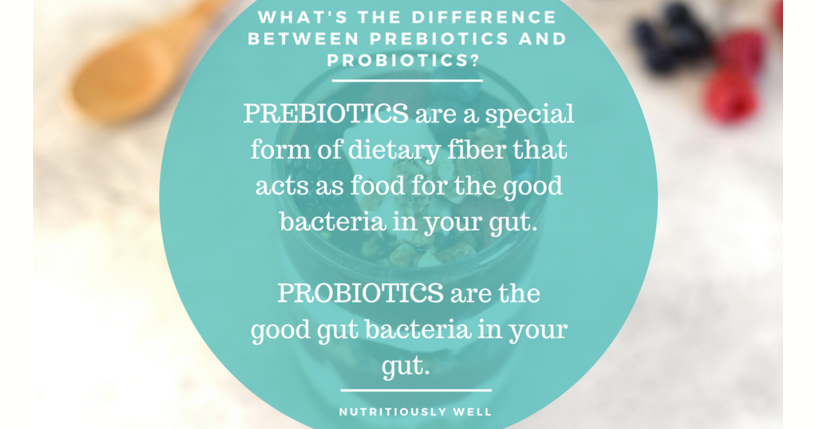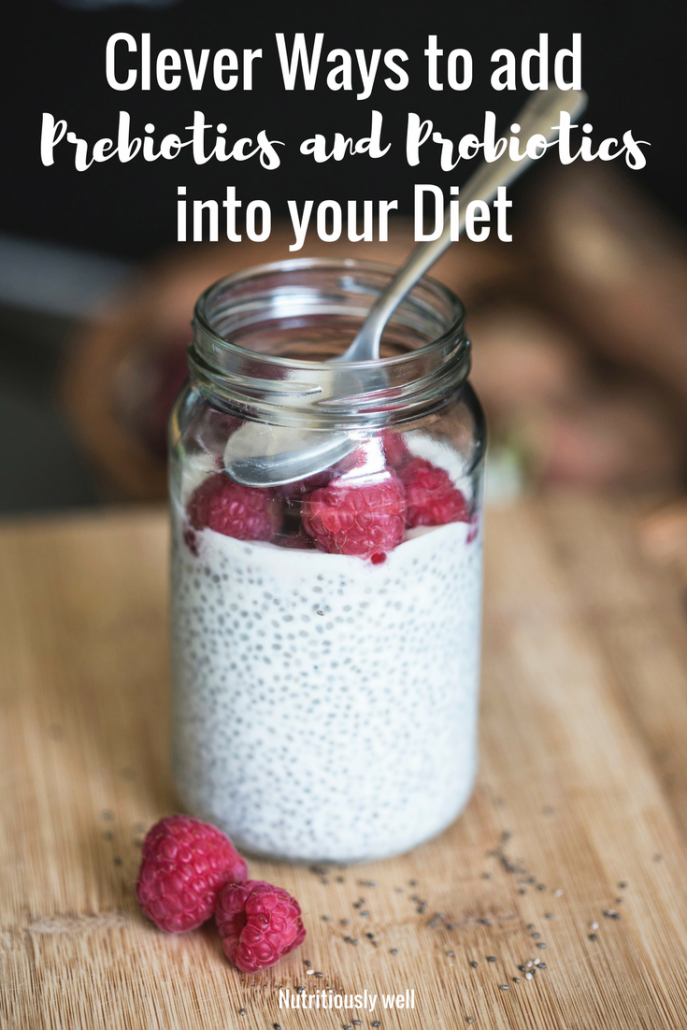Jump Start Your Health with Elizabeth Johnson, RHN
What’s the Difference between Probiotics and Prebiotics?
Clever Ways to Get Gut Healthy Prebiotics and Probiotics Into Your Diet

What’s the Difference between Probiotics and Prebiotics?
Probiotics have become a household name with many of us taking supplements and trying to get them through food. Personally I stick to eating a variety of probiotic rich foods everyday like kombucha, fermented foods and coconut yogurt with added probiotics. You can probably name some probiotic foods, but do you know what they are and their benefits?
Probiotics are popping up everywhere, they’re in yogurt commercials, in pharmacies and grocery stores. In order to understand probiotics we need to understand the gut. Inside your gut there are as many as 100 trillion gut bacteria with good bacteria and some bad bacteria living together in harmony. When you have an imbalance of to many bad bacteria and not enough good bacteria is when problems start to occur. This is where probiotics come in.
Why? Probiotics can help populate your gut with good bacteria because probiotics are live bacteria! When a food or supplement contains probiotics is actually has bacteria in it that continue to live on in your gut.
Choosing a probiotic supplement
Not all probiotics are created equal. Also not everyone should take a probiotic supplement so consult your doctor first. The International Scientific Association for Probiotics and Prebiotics recommends looking at the following criteria before choosing a probiotic:
Proof of efficacy.
- Probiotics must be tested (and be shown effective) in humans to determine health benefits.
Quality and quantity.
- Probiotics can be effective at varying strengths. Scientific studies have determined health benefits from 50 million to more than 1 trillion colony forming units per day.
- A probiotic with higher colony forming units doesn’t necessarily equal better quality or effectiveness.
Package information.
- Strain, quantity of colony forming units, serving size, health benefits, proper storage conditions, expiration date, and additional corporate contact information all should be provided on the label.
Now on to prebiotics!
Though probiotics alone provide very useful benefits, they have a greater effect when combined with prebiotic fiber. Prebiotics are a type of insoluble fiber. Meaning you can’t digest them, but your gut bacteria can and they use them as food to multiply and proliferate. When you eat a diet low in fibre those important gut bacteria that mostly live lower in your digestive tract can starve and this can cause a gut imbalance like I spoke about earlier.
So eating prebiotic foods is important for keeping your gut bacteria healthy.
In return they keep you healthy!
Adding prebiotic and probiotic rich foods is a delicious way to improve your gut health, but how can you add these foods into your diet?
 Best Prebiotic Foods
Best Prebiotic Foods
- Onions, leeks, garlic
- Bananas, apples, pears
- Asparagus
- Jerusalem artichokes, celery root
- Dandelion
- Pure Oats
 Best Probiotic Foods
Best Probiotic Foods
- Yogurt, kefir
- Sauerkraut, kimchi (also a source of prebiotics)
- Kombucha
- Miso, tempeh (made from soy for anyone with allergies)
- Pickles (raw, non-pasteurized)
When adding these foods into your diet you don’t have to worry to much about getting the right amount of pre and probiotics, just get a variety.
Clever Ways to Get Gut Healthy Prebiotics and Probiotics Into Your Diet

Eat Fermented Foods!
- Many fermented foods are the best of both worlds because they’re prebiotics and probiotics. Some examples of fermented foods are sauerkraut and kimchi.
Drink kefir in the morning
- Kefir is a fermented milk product (cow, goat or sheep milk) that tastes like a drinkable yogurt. Kefir benefits include high levels of vitamin B12, calcium, magnesium, vitamin K2, biotin, folate, enzymes and probiotics.
Replace your juice or pop with kombucha
- After being fermented, kombucha becomes carbonated and contains vinegar, B-vitamins, enzymes and probiotics. Look for one that’s low in sugar.
Put yogurt (and bananas) in your smoothies
- It’s recommend when buying yogurt to look for three things: first, that it comes from goat or sheep milk if you’re lactose intolerant or have a dairy sensitivity; second, that it’s grass-fed; and third, that it’s organic. Yogurt is one of the top (and tastiest) probiotic foods. Bananas are rich in fibre and make a great edition to your smoothie.
Add in handful of dandelion greens to your salad
- Dandelion greens are a great fiber-rich substitute for greens in your salad. They are one of the best prebiotics and adding them into a salad is a simple way to fit them into your diet.
Make leek soup
- Leeks are a delicious edition to many soups. They have a mild onion taste and add a yummy flavour. Thanks to their high fibre content they are a great prebiotic.
Eat chocolate (what!! 😀)
- Okay before you get to excited I’m not talking about milk chocolate. I’m talking about raw cocao. It’s a tasty prebiotic food that contains flavanols that increase healthy gut bacteria.
 Elizabeth has just assumed a position with Vancouver Island Naturopathic Clinic & Integrated Health and is looking for ward to supporting you in her capacity there as a Registered Holistic Nutritionist.
Elizabeth has just assumed a position with Vancouver Island Naturopathic Clinic & Integrated Health and is looking for ward to supporting you in her capacity there as a Registered Holistic Nutritionist.
What is Registered Holistic Nutrition?
Holistic Nutrition is a natural approach to dietary health that uses evidence-based techniques to optimize nutrient status and diet. Instead of focusing on just one aspect of the person, or taking a one size fits all methodology, holistic nutrition evaluates the complete health history, emotional state, lifestyle habits and current diet habits of an individual to determine the root cause of his or her health.
What schooling does a Registered Holistic Nutritionist do?
Registered Holistic Nutritionist is a professional trained by the Canadian School of Natural Nutrition (CSNN) to educate individuals and groups about the benefits of nutrition. After a 2 year program through a school of nutrition, students are required to complete 50 practicum hours and pass a board exam, which is the same across Canada.
Why come see a Holistic Nutritionist?
- You’ll get an Individualized food plan based on YOU – your likes, dislikes, food intolerances, allergies, and or lifestyle.
- Stuck in a rut? You’ll get Inspiration, motivation, guidance. It’s like having a personalized food trainer.
- Get to the root cause of your sleep problems, low energy, skin issues, hormonal problems.
- Improve your digestion! Get your digestion on track and feel better.
- Learn strategies to develop a new relationship with food. When you learn how to eat better, your confidence, energy and well being often improves.
- A holistic nutritionist can teach you a holistic model of health by providing not only dietary guidance, but lifestyle suggestions too.
- No quick-fix fad or crash diets. Diets don’t work and are time-limited. Get healthy over time, weight loss will be a side effect, as well as glowing skin, better sleep and better digestion.
Holistic Nutrition can help support these areas:
- Weight loss
- Improving your overall nutrition
- Chronic Health Disorders
- Autoimmune Conditions
- Chronic Pain
- Women’s Health
- Family and Pregnancy Support
- Living with food allergies or intolerances
- Celiac Disease management
- Depression and Anxiety
- Hormonal Issues
- Aging
Are Holistic Nutritionists Covered On Benefits Programs?
It depends which company you use, – more and more companies are starting to cover Holistic Nutritionists. If your benefits plan is under Greenshield or Manulife, may often should be covered; however, it’s typically under “Nutritional Counselling / Social Work / Counselling” and is not the same as being covered with a Registered Dietician or Registered Nutritionist. If your benefits plan is under Sunlife, Great West Life or Pacific Blue Cross, there is a chance it’s covered. Always call your provider to ensure your coverage.
Contact Elizabeth at Vancouver Island Naturopathic Clinic
204-4480 West Saanich Road Victoria, B.C. V8Z 3E9
250.881.1806 | [email protected]
Facebook Twitter
HOURS: Monday & Wednesday: 12 pm – 8 pm Thursday: 9:30 am – 8 pm Tuesday, Friday & Saturday: 9 am – 5 pm Sunday: Closed

Elizabeth Johnson, RHN
About Elizabeth
In 2006, when Elizabeth was 15, she developed digestive symptoms after a case of food poisoning while vacationing in Tampa Bay – a hot dog eaten during triple overtime.
For six more years, her health continued to decline, she lost weight and suffered from severe fatigue, anemia, nausea, vomiting, bloating, fainting spells, joint pain and hair loss. At that point, she was finally diagnosed with celiac disease.
In 2014, while her health improved on a gluten-free diet, her diet of gluten-free processed cookies, pizzas and cakes wasn’t helping her health.
She continued to suffer with many of the same symptoms. After a bad viral infection that lead to viral encephalitis, she was also diagnosed with reactive arthritis. Elizabeth still struggles with ongoing nerve damage and pain on the right side of her body.
Elizabeth decided she had to get serious about restoring her health. She improved her diet, changed her mindset and enrolled in a Holistic Nutrition Diploma program. She discovered first hand how to provide her body with the nourishment it needed and her mind; positive thoughts. It transformed her life.
In 2016, Elizabeth graduated with a Diploma in Holistic Nutrition and started helping others!













